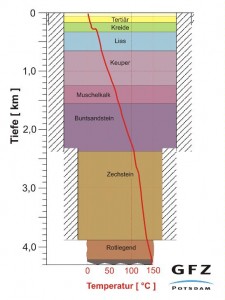GFZ conference announcing development of new geophysical methods
The development of cutting-edge geophysical methods with which potential geothermal reservoirs can be safely explored and directly tapped through, as presented at a conference of GFZ in Potsdam, Germany.
A conference, which I blogged about a couple days ago, was held at GFZ The German Research Center for Geosciences at the Helmholtz Center in Potsdam, Germany. I simply found that the details and pictures of this article are worth reposting.
“120 scientists and industry representatives from the 20 countries participated at the meeting. The aim of this European Union project, in which seven European nations participated, was the development of cutting-edge geophysical methods with which potential geothermal reservoirs can be safely explored and directly tapped. “The new methods deliver important decision-support for the selection of sites for future geothermal projects. With this we can considerably reduce the risk of expensive misdrills“ explains Dr. Ernst Huenges, Head of Geothermal Research at the host institute GFZ.
The European Commission funds the I-GET project with an aim at developing an innovative geothermal exploration approach based on advanced geophysical methods. The objective is to improve the detection, prior to drilling, of fluid bearing zones in naturally and/or artificially fractured geothermal reservoirs.The approach has been tested in four European geological formations with different characteristics, two high temperature volcanic or metamorphic rock, one mid enthalpy in deep sedimentary rocks and a low enthalpy located in shallow sedimentary rocks.
The purpose is to ascertain that the above ground study, measurement and testing as used in the laboratory and simulations can be validated by in-field experiments. Seismic and megnetotelluric data is in hand from the test sites. These data were then examined for new acquisition protocols and processing techniques to solve problems. Geothermal targets exhibit problems outside of other deep rock exploration such as very high temperatures, anisotropy and phase condition. The newly developed techniques were used to build dynamic three-dimensional models of the heat reservoirs to test the quality of the new exploration methods. Then bores were drilled to compare results.
One has to assume the effort paid off. While no claims were made available to the press or public, the titles of the papers hint that the results were worthwhile. Participants had the opportunity to learn about the results of the I-GET project. Due to the thematic emphasis of the project, the program was focused on – but not limited to – geological and geophysical methods in exploration. Independent presentations on similar or different exploration approaches were strongly encouraged to attend the conference and share their experience and ideas with colleagues from all over the world. Of great interest is the wide range of presenters. From Japan, Indonesia, Australia and New Zealand in the east, the U.S. in the west and many European presentations and posters, it must have been a busy couple of days. While all of this seems encouraging and a bit vague, its because the industry is quite young and just now has a world wide conference for the exchange of ideas about pre sight selection and proving up sites before the drill bit hits the dirt. As the oil guys can tell you, this is the smartest money spent.
That’s one of the big issues facing geothermal. Actually the first, as figuring out where, is key to making sound investments and committing to large facilities. That’s why this conference, while small, far away and limited in scope is so important – it addresses the primary step, before any others can be taken to move geothermal as an industry to a larger level. For any practical purpose, all the obvious geothermal sites are well known with leaseholds and other land rights already filed. The big growth must come from new “discoveries” of locations where surface land rights, connection ability to the grid and other site requirements can be met. There is a lot of room for growth, but the first question is “where” and a major step to getting to that has just now happened.”
Source: “Intelligent Use of the Earth’s heat” (GFZ Potsdam), New Energy and Fuel
